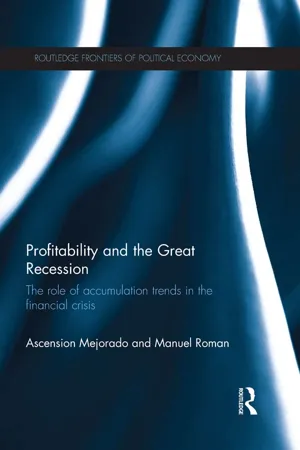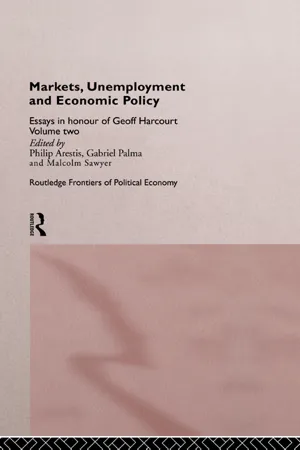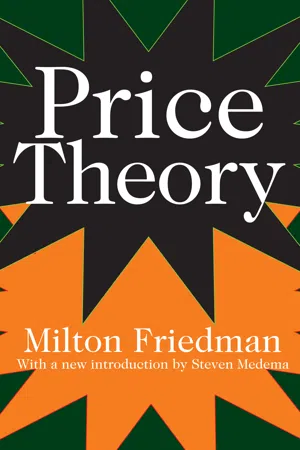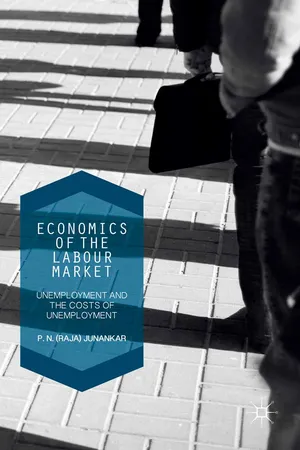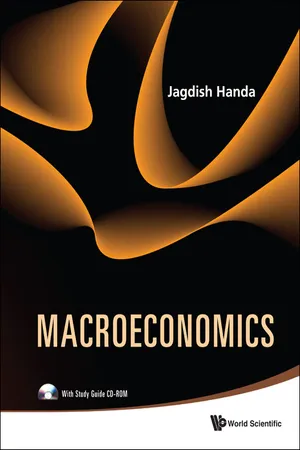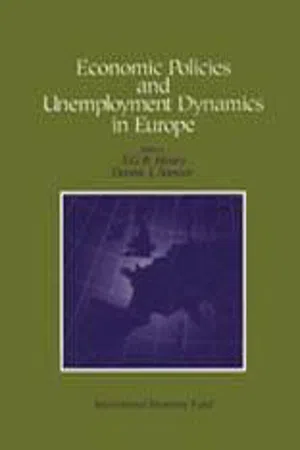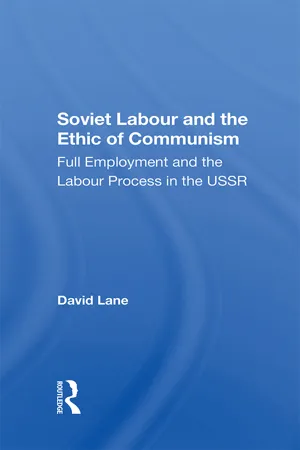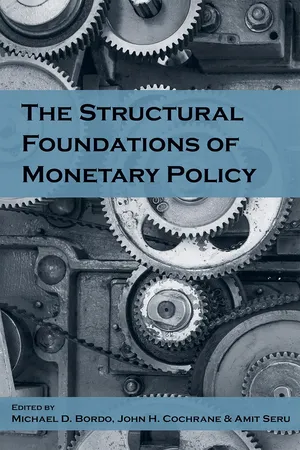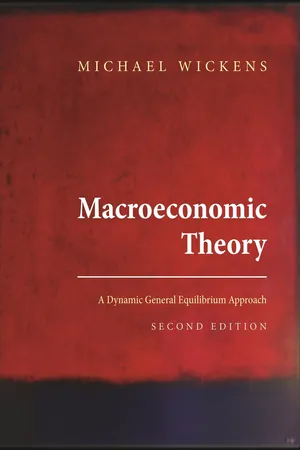Economics
Natural Rate of Unemployment
The natural rate of unemployment refers to the level of unemployment that exists in an economy when it is operating at full potential. It represents the equilibrium level of unemployment that is consistent with the structure of the labor market and other economic factors. This concept helps economists understand the underlying trends in unemployment and assess the health of an economy.
Written by Perlego with AI-assistance
Related key terms
Related key terms
1 of 4
Related key terms
1 of 3
11 Key excerpts on "Natural Rate of Unemployment"
- eBook - ePub
Modern Labor Economics
Theory and Public Policy (International Student Edition)
- Ronald G. Ehrenberg, Robert S. Smith(Authors)
- 2017(Publication Date)
- Routledge(Publisher)
Another defines full employment as the rate of unemployment at which job vacancies equal the number of unemployed workers, and yet another defines it as the level of unemployment at which any increases in aggregate demand will cause no further reductions in unemployment. A variant of the latter defines the natural rate as the unemployment rate at which all unemployment is voluntary (frictional and perhaps seasonal). A final definition of the natural rate is that rate at which the level of unemployment is unchanging and both the flows into unemployment and the duration of unemployment are normal. 45 All the various earlier definitions try to define in a specific way a more general concept of full employment as the rate that prevails in “normal” times. If we assume that frictional and seasonal unemployment exist even in labor markets characterized by equilibrium (that is, markets having neither excess demand nor excess supply), it is clear that the Natural Rate of Unemployment is affected by such factors as voluntary turnover rates among employed workers, movements in and out of the labor force, and the length of time it takes for the unemployed to find acceptable jobs. These factors vary widely across demographic groups, so the natural rate during any period is strongly influenced by the demographic composition of the labor force. Unemployment and Demographic Characteristics Table 14.4 presents data on actual unemployment rates for various age/ race/gender/ethnic groups in 2015, a year in which the overall unemployment was a moderate 5.3 percent - eBook - ePub
- Ascension Mejorado, Manuel Roman(Authors)
- 2013(Publication Date)
- Routledge(Publisher)
Milton Friedman's acknowledgement that the neoclassical concept of general equilibrium is compatible with a persistent measure of unemployment allowed neoclassical theory to resolve a glaring conflict between theory and reality. Addressing the American Economic Association in 1967, he said:At any moment of time, there is some level of unemployment which has the property that it is consistent with equilibrium in the structure of real wage rates. At that level of unemployment, real wage rates are tending on the average to rise at a “normal” secular rate, i.e., at a rate that can be indefinitely maintained so long as capital formation, technological improvements, etc., remain on their long-run trends. A lower level of unemployment is an indication that there is an excess demand for labor that will produce upward pressure on real wage rates. A higher level of unemployment is an indication that there is an excess supply of labor that will produce downward pressure on real wage rates. The “Natural Rate of Unemployment,” in other words, is the level that would be ground out by the Walrasian system of general equilibrium equations, provided there is imbedded in them the actual structural characteristics of the labor and commodity markets, including market imperfections, stochastic variability in demands and supplies, the cost of gathering information about job vacancies and labor availabilities, the costs of mobility, and so on.(Friedman, 1968, p. 8)Friedman's acceptance of a “Natural Rate of Unemployment” provided a much needed dialectical solution to the neoclassical conundrum. Confronting the reality of persistent unemployment that appeared to contradict the conclusions derived from the general equilibrium approach of neoclassical economics, Friedman developed a more nuanced concept of full employment which, in theory, resolved the contradiction. The unemployment reality challenging the integrity of neoclassical concepts lost its theoretical import once Friedman's new concept of full employment absorbed it as one of its structural elements, thereby denying its negative significance: - eBook - ePub
- Philip Arestis, Gabriel Palma, Malcolm Sawyer(Authors)
- 2005(Publication Date)
- Routledge(Publisher)
In thinking about unemployment, a second focus of concern of economists, in addition to the unmet demand for paid employment, is the relationship between the labour market and developments in the macroeconomy – particularly wage and price inflation. The focus here is on unemployment as a measure of excess supply or demand for labour and its implications for wage inflation. Keynes’s estimates, in the 1930s and 1940s, of the ‘normal’ level of unemployment consistent with money wage stability (when involuntary unemployment was zero, i.e. full employment) exceeded by a wide margin the rate of unemployment which was consistent with non-accelerating inflation during the post-war full employment era down to the mid-1970s. ‘Normal’ unemployment evolved, in Friedman’s hands, into the ‘natural’ rate, which he defined as the rate consistent with a stable functional distribution of income:At that level of unemployment, real wage rates are tending, on average, to rise at a ‘normal’ secular rate i.e. at a rate that can be indefinitely maintained so long as capital formation, technological improvements etc. remain on their long-run trends.(1968: 8)Any attempt to hold unemployment below the ‘natural’ rate would result in accelerating inflation and a shift in the functional distribution against profits. The ‘natural’ rate developed into the NAIRU (the non-accelerating inflation rate of unemployment) – with all its attendant problems of estimation. Attention focused on the difference between the actual and the NAIRU as a measure of excess demand in the labour market. Of course, estimates of the NAIRU are shrouded in controversy, and the difference between actual and NAIRU cannot be taken as an estimate of ‘involuntary unemployment’.The ILO/OECD measure of ‘search’ and ‘availability’ unemployment, i.e. those who demonstrate active participation in the labour market, can be seen as the answer to the search for a measure of excess labour supply which is relevant from the point of view of money wage determination, and, hence, inflation. Most economists, however much they believe in the role of social, institutional and historic factors in wage determination, also accept that market conditions play their part through, for example, influencing the relative bargaining strength of employers vis-à-vis employees. However, not all ‘search’ unemployed, as measured by the ILO, exert an equal influence on wage determination. Layard et al - eBook - ePub
- Milton Friedman(Author)
- 2017(Publication Date)
- Routledge(Publisher)
The term the natural rate has been misunderstood. It does not refer to some irreducible minimum of unemployment. It refers rather to that rate of employment which is consistent with the existing real conditions in the labor market. It can be lowered by removing obstacles in the labor market, by reducing friction. It can be raised by introducing additional obstacles. The purpose of the concept is to separate the monetary from the nonmonetary aspects of the employment situation—precisely the same purpose that Wick-sell had in using the word natural in connection with the rate of interest. In the past few years, a large number of statistical studies have investigated the question whether the long-run Phillips curve is or is not vertical. That dispute is still in train. Most of the statistical tests were undertaken by rewriting equation 2 in the form: where the left-hand side was either the rate of change of wages or the rate of change of prices. The question then asked was the value of b. 16 The original Phillips curve essentially assumed b = 0; the acceleration hypothesis set b equal to 1. The authors of the various tests I am referring to used observed data, mostly time-series data, to estimate the numerical value of b. 17 Almost every such test has come out with a numerical value of b less than 1, implying that there is a long-run “trade-off.” 18 However, there are a number of difficulties with these tests, some on a rather superficial level, others on a much more fundamental level. One obvious statistical problem is that the statistically fitted curves have not been the same for different periods of fit and have produced very unreliable extrapolations for periods subsequent to the period of fit. So it looks very much as if the statistical results are really measuring a short-term relationship despite the objective. The key problem here is that, in order to make the statistical test, it is necessary to have some measure of the anticipated rate of inflation - eBook - ePub
Economics of the Labour Market
Unemployment, Long-Term Unemployment and the Costs of Unemployment
- P. N. (Raja) Junankar, P. N. (Raja) Junankar(Authors)
- 2016(Publication Date)
- Palgrave Macmillan(Publisher)
This theory also assumes that search is more efficient when unemployed rather than when employed. This assumption, however, is unlikely to be supported by by evidence. However, given Australian industrial relations system individuals cannot accept wages below award rates, and of course employers may not offer such rates. Thus, individuals would be involuntarily unemployed. Finally, we should also mention the efficiency wage theories and the natural rate school. The former explanation of unemployment is based on the efficiency wage arguments: employers pay a wage higher than market clearing rates because they get higher productivity from the workers (see Akerlof and Yellen (1986)). On the other hand, the natural rate school economists think in terms of a Natural Rate of Unemployment, or a non-accelerating inflation rate of unemployment (NATRU) derived from Phillips curve estimates. However, recent work which stresses the problem of hysteresis (or dependence on the past situation in the labour market) suggests that the concept of a natural rate which increases with the actual rate is not a very useful analytical concept. 5 In fact, recent empirical work has produced estimates of such a natural unemployment rate which range from 5% to 8% making an arbitrarily selected value from this interval not a very useful tool in assessing the costs of unemployment. 6 However, for the purposes of considering alternative “scenarios” we have selected a particular value of this so-called natural rate, namely 6.5% - eBook - ePub
Macroeconomics
(With Study Guide CD-ROM)
- Jagdish Handa(Author)
- 2010(Publication Date)
- WSPC(Publisher)
CHAPTER 7Full-Employment Output and the Natural Rate of UnemploymentThe study of real output in the economy requires the analysis of the labor market and the aggregate supply of commodities for the economy. The main variables of interest in this analysis are the long-run levels of employment and output, and the Natural Rate of Unemployment. Their derivation is distinct from that of the short-run behavior of the economy (covered in Chapter 8 ) and of the disequilibrium behavior of the economy (covered in Chapter 9 ).The long-run behavior of the economy, captured under the notions of the full-employment level of output and the Natural Rate of Unemployment, is presented in this chapter.The counterpart of the aggregate demand for commodities is their aggregate supply. This chapter presents the derivation of the long-run (LR) equilibrium levels of employment and output. This expression is usually shortened to the ‘long-run levels’, thereby dropping the word ‘equilibrium’ but implying it nevertheless. The LR aggregate output in the economy is also known as the full-employment output.As Chapter 1 explained, the full-employment output in macroeconomics is to be interpreted as the optimal output that can be produced on a sustainable basis over long periods from the efficient use of the economy's available factors of production and its available technology — given the economy's organizational and market structures,1 the wishes of the owners of the factors of production,2 as well as its economic, social, and political structures. This full-employment output is often more loosely referred to as the ‘potential long-run output’ that can be maintained with the economy's current resources and structures. In more formal terms, the full-employment level of output is defined as the long-run equilibrium level of output, where the term ‘long run’ refers to that analytical period when there are no rigidities, adjustment costs or expectational errors. - INTERNATIONAL MONETARY FUND(Author)
- 1997(Publication Date)
- INTERNATIONAL MONETARY FUND(Publisher)
This book is a step toward righting the balance, by focusing not only on the structural deterioration of European labor markets (as in Layard, Nickell, and Jackman (1991)), but also on the determinants of sluggish labor market adjustment. Thus far, the literature on unemployment has concentrated on two polar extremes of unemployment dynamics: the natural rate and hysteresis models. According to the natural rate models, unemployment can be divided into two major components: (1) the long-run equilibrium rate of unemployment, which is the unemployment rate determined by the structural characteristics of the economy: technologies, endowments, preferences, and the degree of competition; and (2) random short-run deviations from that rate caused by temporary frictions. In contrast, the hysteresis hypothesis asserts that the unemployment rate tends to “get stuck” at whatever its current rate happens to be. (More precisely, the current unemployment rate is asserted to be the best predictor of the future unemployment rate.) Here every unemployment rate can be a long-run rate and the effects of temporary labor market shocks persist indefinitely. We will argue that neither of these hypotheses squares well with the central features of European unemployment experience. On the one hand, European unemployment rates can diverge from their long-run “natural” rates for substantial periods of time; on the other, unemployment rates show too great a tendency to return to a limited range of values to be explained by pure hysteresis. The argument we advance is that adjustment dynamics are a neglected dimension of the unemployment problem. Following Snower and Karanassou (1995), this chapter contends that the sluggishness with which the labor market responds to shocks can be a major force keeping unemployment high following a shock, and this tendency often persists for long periods of time- Merijn Knibbe(Author)
- 2019(Publication Date)
- Routledge(Publisher)
Wall Street Journal ( Dalton 2016) and Voxeu (Fioramanti and Waldmann 2016). Casares and Vasquez are also not satisfied by the idea that 22 percent unemployment is ‘natural’ and explain extreme unemployment in Spain using ‘habit persistence’ as well as wages which are set too high by the households (the models are not explicit about the coordination mechanism), which lures too many people to the labor market. Such studies however still use the general equilibrium framework and the assumption that the ‘right’ level of real wages will quickly solve the problem of unemployment, either by driving people out of the labor force or by increasing production. (Un)employment and wages statistics are not kind to this idea, surely not as real wages in countries like Spain and Greece and the UK (Tily 2016) showed considerable decreases without a concomitant drop in the participation rate. The basic ideas are not changed.A more fundamental change is proposed by Roger Farmer, who sticks to the use of microeconomic utility functions to derive intertemporal optimization of consumption (perhaps the most accessible of his articles: Farmer 2013). But he cuts the consumption-wage-employment nexus out of the models by introducing a subtle change. Expectations are not, by assumption, consistent with the unique equilibrium, anymore. They are, in a sense, part of the cultural technology of a society and drive the level and nature of investments in a certain direction. This changes the path the economy takes – and alters the final equilibrium. It’s the difference between water going down a drain (DSGE models) and a marble rolling over an uneven pavement (the Farmer model). Despite possible initial disturbances water in a bathtub will go down the drain in a predictable way (the equilibrium situation). But a seemingly small difference in direction might make the marble run into a small object, change course and end up in a hole – the hole being high unemployment. Households do not by assumption equilibrate consumption, investment and work in the long run in this model. Once in a hole, they will know that they can’t get out individually and act accordingly by cutting spending, even when they would be able to get out together, by conscious coordination. By severing the long run equilibrium relation between consumption, wages and labor supply he also destroys the general equilibrium and ‘natural unemployment’ setting of these models, which enables a model with ‘multiple equilibria’. Such a model enables a better description about what happened in Finland and Sweden in 1991, in Spain and Greece after 2008 or in Poland and Bulgaria and Eastern Germany after 1992: very long lasting extreme levels of unemployment: more than 15 or even 20 percent for the better part of a decade. Farmer is also much more explicit about the differences between hours, people and the participation rate and does not shy away from a slightly inductive approach, taking (un)employment statistics at face value. Instead of a DSGE model (dynamic stochastic general equilibrium) such models might be called DSIE models, with ‘I’ for ‘indeterminate’. At this moment, Farmer is however not a representative DSGE economist. As he states it: ‘Persistent expectations is a strike against rational expectations PLUS the uniqueness [economies are like bathtubs, M.K.] assumption. It is the uniqueness assumption that needs to go; not the rational expectations assumption which simply reflects a fact that we have known for a long time: Expectations are incredibly persistent- eBook - ePub
Soviet Labour And The Ethic Of Communism
Full Employment And The Labour Process In The Ussr
- David Lane(Author)
- 2019(Publication Date)
- Routledge(Publisher)
1Figure 4.1: Frictional unemploymentIn market economies, it is usually reckoned that even with full employment, 2-3 per cent of the workforce will remain 'frictionally' unemployed. 'Frictional' unemployment is not usually counted in market economies as giving a person an unemployed status. The length of the period recognized as being 'between jobs', or actively seeking work, makes a great deal of difference to unemployment statistics. People unsuccessfully seeking work for less than four weeks are usually excluded, and in some countries, such as Sweden, the qualifying period is as much as 60 days.2Measurement of Turnover
Frictional unemployment is the major source on which the rate of unemployment in the Soviet Union has been estimated by western experts. Such estimates are based on extrapolation from data on turnover (tekuchest '). These include people who voluntarily leave or are dismissed, but exclude those who retire, join the armed forces, are transferred to other enterprises or participate in 'organized transfers' (orgnabor ). On such a basis, Mesa-Lago and Peter Wiles have attempted to calculate total Soviet unemployment rates forthe 1950s and 1960s. Mesa-Lago3 calculates that in 1960, 20 per cent of the workforce lost an average of 27 work days as a result of changing jobs: this gives a rate of 'aggregate unemployment' at 3.3 per cent. As Mesa-Lago points out, however, the statistical basis for these calculations has some flaws. Turnover may not have involved any time-lags in some cases and the average days lost may not be representative of the whole: turnover varies enormously between areas4 (see below). Nevertheless, Mesa-Lago concludes that a rate of 2-3 per cent is 'roughly indicative of the importance of frictional unemployment in the USSR due to job shifts among industrial workers'.5 Paul R. Gregory, on the basis of interviews conducted in the early 1980s with 2,800 Soviet emigrés living in the United States, estimates that the level of unemployment is 2½ to 3 per cent.6 Peter Wiles, basing his estimate on a 30 calendar day average idleness for a jobchanger in Krasnoyarsk city, calculates a 1.3 per cent frictional unemployment rate for the USSR.7 In the Soviet journal Trud in 1974, it was reported that in the RSFSR 3.5 million people in industry and building changed jobs: it was further calculated that this represented a loss of 400,000 person work years. If one expresses this as a proportion of total employment in industry and building one may calculate an annual rate of frictional employment of 1.5 per cent.8 In the Belorussian Republic in 1976/77, it has been calculated that the equivalent of 10-11,000 people were lost to production in industry and building as a result of turnover.9 This represents a loss of under one per cent per year.10 - eBook - ePub
- Michael D. Bordo, John H. Cochrane, Amit Seru, Michael D. Bordo, John H. Cochrane, Amit Seru(Authors)
- 2018(Publication Date)
- Hoover Institution Press(Publisher)
The first equilibrium rate concept is a purely short-run equilibrium. It is often referred to as the natural rate and is well formulated in New Keynesian dynamic stochastic general equilibrium (DSGE) models, where it corresponds to the value of the real interest rate that would be realized if prices are flexible (Neiss and Nelson 2003; Woodford 2003). This short-run equilibrium is influenced by temporary shocks other than monetary policy shocks. Estimates of this natural rate often exhibit greater variability than actual real interest rates, which are influenced by the presence of price rigidities. Some recent contributions have recommended that the central bank set policy rates in a way that drives the actual real interest rate to the value of this short-run natural rate (Barsky, Justiniano, and Melosi 2014; Curdia et al. 2015). Clearly, such a policy is highly model and shock dependent. It is not robust to model uncertainty but rather sensitive to the respective model specification.Laubach and Williams (2003) introduced another equilibrium rate concept that has received much attention. This concept is of a medium-run nature. Its derivation is based on a mixture of atheoretical time-series methods and a simple Keynesian-style model consisting of an aggregate demand relationship and a Phillips curve relationship. The equilibrium rate is modeled as the function of potential growth and some preference parameters, similar to a fully specified general equilibrium model without imposing the cross-equation restrictions of such models. Equilibrium rate, potential GDP growth, and preference parameters are unobserved variables. How much they move depends on technical parameters of the unobserved components time-series specification. More recently, Laubach and Williams (2016) and Holston, Laubach, and Williams (2017) have provided updated estimates indicating a sharp decline toward values around 0 percent for the United States and lower values in the euro area. These estimates have had a substantial impact on policy making. Yet they are characterized by a large degree of imprecision, instability, and potential estimation bias (GCEE 2015; Taylor and Wieland 2016; Beyer and Wieland 2017).A third concept is the long-run equilibrium rate or steady-state interest rate. The New Keynesian DSGE models that can be used to derive a short-run natural rate also include a long-run equilibrium rate or steady-state rate to which the short-run rate converges over time. This long-run equilibrium rate is a function of steady-state growth (per capita) and household rates of time preference and elasticity of substitution. Since the effects of price rigidities are temporary, the long-run equilibrium rate in New Keynesian DSGE models is equivalent to the equilibrium rate in a model of real economic growth (see, for example, Christiano, Eichenbaum, and Evans 2005; Smets and Wouters 2007). - eBook - ePub
Macroeconomic Theory
A Dynamic General Equilibrium Approach - Second Edition
- Michael Wickens(Author)
- 2012(Publication Date)
- Princeton University Press(Publisher)
To clarify matters it is helpful to distinguish between different types of unemployment. First, involuntary unemployment is where a person is willing to take a job at the going wage but none is available. This is the common meaning of unemployment. It is usually attributed to recessions and it is what traditional Keynesian economics is largely concerned with. Involuntary unemployment is mainly temporary. It varies with the business cycle and largely disappears in booms. Second, frictional unemployment is due, for example, to the flow of workers between jobs and the problem of matching job vacancies with those searching for work. The failure to find a match results in unemployment. Such unemployment, although varying over time, is always present. It helps to explain why unemployment is a permanent feature and may exist even when labor markets are in equilibrium and there are unfilled vacancies. Not surprisingly, much of the recent DSGE literature adopts this approach as frictional unemployment is easier to incorporate into equilibrium DSGE models than involuntary unemployment. Third is voluntary unemployment: people who claim unemployment benefits but are not seeking work. In effect, they are not offering to supply labor and so are not participating in the labor market. We will therefore regard such people as not being part of the labor force, and hence not unemployed. Nonetheless, it should be said that such people may be looking for work but are unable to find a job that provides a wage higher than the state benefits they receive, meaning that they would be financially worse off if they accepted a job. This situation is more prevalent in Europe than in the United States, where state benefits are generally lower. We also ignore those who work a few hours on a casual or informal basis, either for others or for themselves at home.Continuous labor market equilibrium and clearing, and hence the absence of involuntary unemployment, requires perfectly flexible real wages. It was argued in chapter 9
Index pages curate the most relevant extracts from our library of academic textbooks. They’ve been created using an in-house natural language model (NLM), each adding context and meaning to key research topics.
Explore more topic indexes
Explore more topic indexes
1 of 6
Explore more topic indexes
1 of 4

